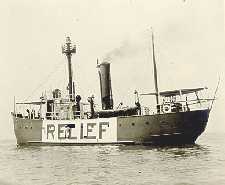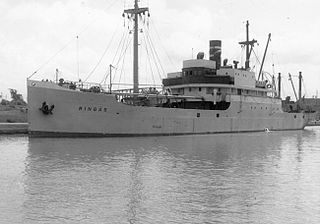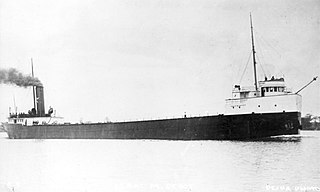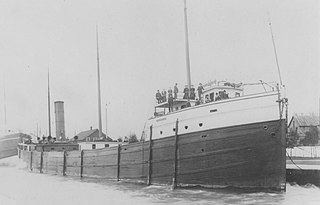
Lake Huron is one of the five Great Lakes of North America. Hydrologically, it comprises the easterly portion of Lake Michigan–Huron, having the same surface elevation as its westerly counterpart, to which it is connected by the 5-mile-wide (8.0 km), 20-fathom-deep Straits of Mackinac. It is shared on the north and east by the Canadian province of Ontario and on the south and west by the U.S. state of Michigan. The name of the lake is derived from early French explorers who named it for the Huron people inhabiting the region. The Huronian glaciation was named from evidence collected from Lake Huron region. The northern parts of the lake include the North Channel and Georgian Bay. Saginaw Bay is located in the southwest corner of the lake. The main inlet is the St. Marys River, and the main outlet is the St. Clair River.

A lightvessel, or lightship, is a ship that acts as a lighthouse. They are used in waters that are too deep or otherwise unsuitable for lighthouse construction. Although some records exist of fire beacons being placed on ships in Roman times, the first modern lightvessel was off the Nore sandbank at the mouth of the River Thames in England, placed there by its inventor Robert Hamblin in 1734. The type has become largely obsolete; lighthouses replaced some stations as the construction techniques for lighthouses advanced, while large, automated buoys replaced others.

SS Edmund Fitzgerald was an American Great Lakes freighter that sank in Lake Superior during a storm on November 10, 1975, with the loss of the entire crew of 29 men. When launched on June 7, 1958, she was the largest ship on North America's Great Lakes, and she remains the largest to have sunk there. She was located in deep water on November 14, 1975, by a U.S. Navy aircraft detecting magnetic anomalies, and found soon afterwards to be in two large pieces.

USCGC Mesquite (WAGL/WLB-305) was the lead ship in the Mesquite class of seagoing buoy tenders operated by the United States Coast Guard. She served in the Pacific during World War II, and spent the rest of her Coast Guard career in the Great Lakes. She ran aground and was wrecked in December 1989 off the Keweenaw Peninsula in Lake Superior. She was scuttled nearby as a recreational diving attraction.

Lake freighters, or lakers, are bulk carrier vessels that ply the Great Lakes of North America. These vessels are traditionally called boats, although classified as ships.

The United States lightship Huron (LV-103) is a lightvessel that was launched in 1920. She is now a museum ship moored in Pine Grove Park, Port Huron, St. Clair County, Michigan.

SS Carl D. Bradley was an American self-unloading Great Lakes freighter that sank in a Lake Michigan storm on November 18, 1958. Of the 35 crew members, 33 died in the sinking. Twenty-three were from the port town of Rogers City, Michigan, United States. Her sinking was likely caused by structural failure from the brittle steel used in her construction.
Nancy was a schooner, built in Detroit, Michigan and launched in 1789. She served for several years in the fur trade on the Great Lakes, but is best known for playing a part in the Anglo-American War of 1812. She served for several years as a vital supply ship for the Provincial Marine. The Royal Navy took over the Provincial Marine in 1814 and so acquired Nancy. After HMS Nancy was blocked in by an American fleet near the mouth of the Nottawasaga River, her crew set her on fire on 14 August 1814 to prevent the capture of the ship and the cargo she carried. Forgotten for many years, the wreck was re-discovered in July 1927 and raised to form the centrepiece of the Nancy Island Museum.

The Mataafa Storm of 1905, was a storm that occurred on the Great Lakes on November 27–28, 1905. The system moved across the Great Basin with moderate depth on November 26 and November 27, then east-northeastward across the Great Lakes on November 28. Fresh east winds were forecast for the afternoon and evening of November 27, with storm warnings in effect by the morning of November 28. Storm-force winds and heavy snows accompanied the cyclone's passage. The storm, named after the steamship Mataafa, ended up destroying or damaging about 29 vessels, killing 36 seamen, and causing shipping losses of US$ 3.567 million on Lake Superior.

The SS Regina was a cargo ship built for the Merchant Mutual Line and home ported in Montreal, Quebec. Named after Regina, Saskatchewan, Regina had a tonnage of 1,956 gross register tons (GRT) and a crew of 32.

The Rock of Ages Light is a U.S. Coast Guard lighthouse on a small rock outcropping approximately 2.25 miles (3.62 km) west of Washington Island and 3.5 miles (5.6 km) west of Isle Royale, in Eagle Harbor Township, Keweenaw County, Michigan. It is an active aid to navigation.

Spectacle Reef Light is a lighthouse 11 miles (18 km) east of the Straits of Mackinac and is located at the northern end of Lake Huron, Michigan. It was designed and built by Colonel Orlando Metcalfe Poe and Major Godfrey Weitzel, and was the most expensive lighthouse ever built on the Great Lakes.

CGS Simcoe was a lighthouse supply and buoy vessel of the Canadian government acquired for service on the Great Lakes. Entering service in 1909, Simcoe was active until 1917 when the vessel foundered while transiting to Saint John, New Brunswick with the loss of 44 persons.

SS Myron was a wooden steamship built in 1888. She spent her 31-year career as lumber hooker, towing schooner barges on the Great Lakes. She sank in 1919, in a Lake Superior November gale. All of her 17 crew members were killed but her captain survived. He was found drifting on wreckage near Ile Parisienne. Her tow, the Miztec, survived. Myron defied the adage that Lake Superior "seldom gives up her dead" when all 17 crewmembers were found frozen to death wearing their life jackets. Local residents chopped eight of Myron's sailors from the ice on the shore of Whitefish Bay and buried them at the Mission Hill Cemetery in Bay Mills Township, Michigan.

Francisco Morazan was a 1,442 GRT cargo ship that was built in 1922 as Arcadia by Deutsche Werft, Hamburg, for German owners. She was sold in 1934 and renamed Elbing. She was seized by the Allies in the River Elbe, Germany in May 1945, passed to the United Kingdom's Ministry of War Transport and renamed Empire Congress. In 1946, she was allocated to the Norwegian Government and renamed Brunes.

SS Isaac M. Scott was an American Great Lakes freighter that sank during the Great Lakes Storm of 1913 in Lake Huron, 6 to 7 miles northeast of Thunder Bay Island, while she was traveling from Cleveland, Ohio, United States to Milwaukee, Wisconsin, United States with a cargo of coal.

SS Choctaw was a steel-hulled American freighter in service between 1892 and 1915, on the Great Lakes of North America. She was a so-called monitor vessel, containing elements of traditional lake freighters and the whaleback ships designed by Alexander McDougall. Choctaw was built in 1892 by the Cleveland Shipbuilding Company in Cleveland, Ohio, and was originally owned by the Lake Superior Iron Company. She was sold to the Cleveland-Cliffs Iron Company in 1894 and spent the rest of her working life with it. On her regular route between Detroit, Escanaba, Marquette, and Cleveland, Ohio, she carried iron ore downbound, and coal upbound.

Iosco was a Great Lakes freighter that served on the Great Lakes from her construction in 1891 to her foundering on September 2, 1905, when she and her tow, the schooner barge Olive Jeanette sank on Lake Superior. While Olive Jeanette's wreck was located in over 300 feet (91 m) of water about eight miles (13 km) off the Huron Islands in the 1990s, Iosco's wreck has not yet been found.

SS Russia was an iron-hulled American Great Lakes package freighter that sank in a Lake Huron gale on April 30, 1909, near DeTour Village, Michigan, with all 22 of her crew and one passenger surviving.


















